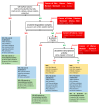Why Is Wnt/β-Catenin Not Yet Targeted in Routine Cancer Care?
- PMID: 39065798
- PMCID: PMC11279613
- DOI: 10.3390/ph17070949
Why Is Wnt/β-Catenin Not Yet Targeted in Routine Cancer Care?
Abstract
Despite significant progress in cancer prevention, screening, and treatment, the still limited number of therapeutic options is an obstacle towards increasing the cancer cure rate. In recent years, many efforts were put forth to develop therapeutics that selectively target different components of the oncogenic Wnt/β-catenin signaling pathway. These include small molecule inhibitors, antibodies, and more recently, gene-based approaches. Although some of them showed promising outcomes in clinical trials, the Wnt/β-catenin pathway is still not targeted in routine clinical practice for cancer management. As for most anticancer treatments, a critical limitation to the use of Wnt/β-catenin inhibitors is their therapeutic index, i.e., the difficulty of combining effective anticancer activity with acceptable toxicity. Protecting healthy tissues from the effects of Wnt/β-catenin inhibitors is a major issue due to the vital role of the Wnt/β-catenin signaling pathway in adult tissue homeostasis and regeneration. In this review, we provide an up-to-date summary of clinical trials on Wnt/β-catenin pathway inhibitors, examine their anti-tumor activity and associated adverse events, and explore strategies under development to improve the benefit/risk profile of this therapeutic approach.
Keywords: ADC; Wnt/β-catenin; cancer therapy; clinical trials; drug combination; drug design; drug profiling; nanovectorization; precision medicine; small molecule inhibitors.
Conflict of interest statement
Author Fabien Granier was employed by the company FGHI. The remaining authors declare that the research was conducted in the absence of any commercial or financial relationships that could be construed as a potential conflict of interest.
Figures








References
-
- Basham K.J., Rodriguez S., Turcu A.F., Lerario A.M., Logan C.Y., Rysztak M.R., Gomez-Sanchez C.E., Breault D.T., Koo B.-K., Clevers H., et al. A ZNRF3-Dependent Wnt/β-Catenin Signaling Gradient Is Required for Adrenal Homeostasis. Genes Dev. 2019;33:209–220. doi: 10.1101/gad.317412.118. - DOI - PMC - PubMed
Publication types
Grants and funding
LinkOut - more resources
Full Text Sources
Research Materials

